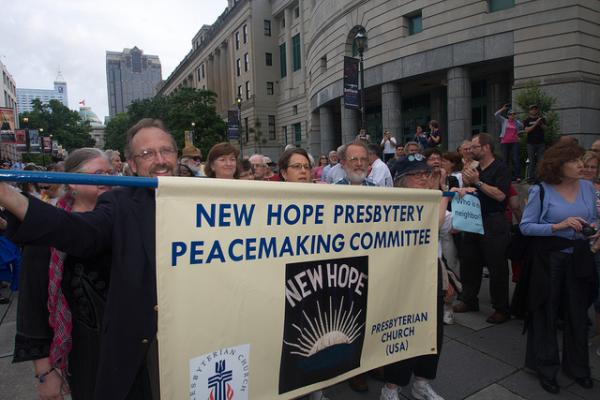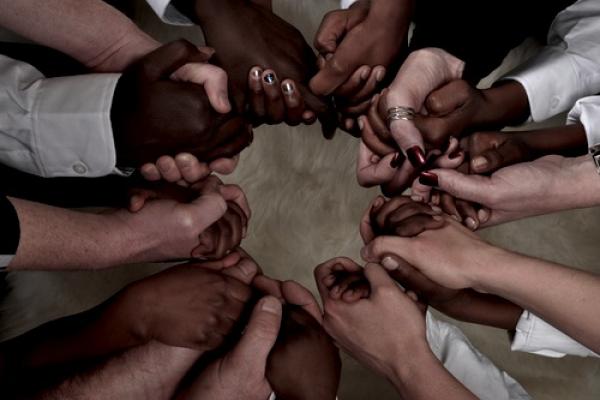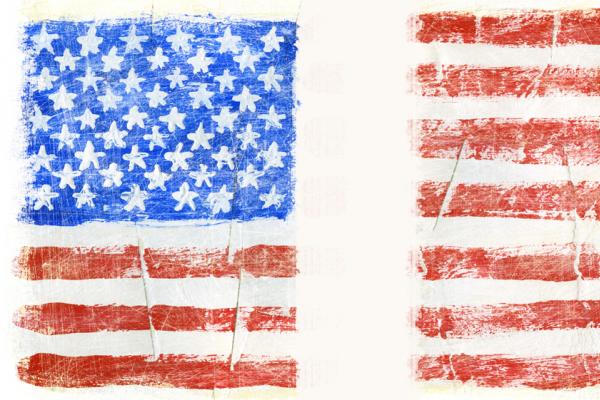On Wednesday, July 10th, when most eyes were on the private GOP meeting where republicans gathered in the Capitol basement to strategize on immigration reform in the House, advocates were rallying outside House buildings to urge members to enact immigration reform.
Uncertain of what the next steps are in the House, hundreds of activists, families, and faith leaders all gathered proudly and united in front of the Cannon and Longworth House Office Buildings as they chanted loudly, “Si se puede!”
Not discouraged by the hot summer heat, marchers hoped to catch GOP members as they ended their internal meeting and walked back to their offices.
Since state legislators were taken over by the Koch brothers, many progressive clergy have spent our entire discretionary accounts on travel to our state capitals. We attend on behalf of equal marriage, the living wage, campaign finance reform, fracking, or low wage workers. While trying to be faithful, we are, also, in the great words of Joseph Sittler, “macerated” by our citizen involvements.
But an experiment is occurring in North Carolina to de-macerate and reunite our spiritual souls with our political bodies. Instead of episodic lobbying, on Moral Mondays, clergy visit with their representatives as chaplains. They change the language from the pragmatics of the political to the hope of our God. They pass through the wilderness of the secular and its optimism and arrive at the land of hope. They talk about the downtrodden in meaningful ways with state legislators.
In a report obtained by the Los Angeles Times, the Energy Department said Thursday that power plants are at risk of being shut down due to the effects of climate change. With the rise of temperatures and sea levels and decreased water resources, the Energy Department advises officials to become more environmentally aware of their natural disaster plans as their ideas could permanently affect the future of Earth's climate. The Los Angeles Times reports:
The report calls on federal, state and local governments to more urgently prepare crucial infrastructure - particularly coal, natural gas and nuclear plants - for the compounded risks posed by floods, storms, wildfires and droughts.
"All of our science goes in one direction: The damages are going to get worse,” Assistant Energy Secretary Jonathan Pershing said. “It will take dozens of actors from government and private sectors planning what to do and how to make it cost-effective.”
Read more here.
Death is horrible enough. But systematic injustice — one that allows white boys to assume success, yet leads black boys to cower from the very institutions created to protect our own wellbeing — is a travesty. Listen to the stories from Saturday and Sunday nights, of 12-year-old black boys who asked to sleep in bed with their parents because they were afraid. If black youth in America can’t rely on the police, the law, or their own neighborhood for protection — where can they go?
The recent “not guilty” verdict out of Sanford, FL, reflects the principle of the American legal system that if there is reasonable doubt, courts will err on the side of innocence. I dispute neither the principle nor the decision by the jury. But that doesn't leave me satisfied about the outcome.
Jesus said that true justice exceeds that of “the scribes and Pharisees” — and the same could be said of the prosecution and defense. Legal justice seeks only to assign guilt or innocence. Holistic justice works for the life, liberty, and well-being of all. And it especially works for reconciliation between the two Americas that can be identified by their reaction to the case.
The number of those who’ve benefitted from the Supplemental Nutrition Assistance Program (SNAP) has increased nearly seven percent from 8.7 in 2007 to 15.2 in its most recent study. Despite the economic challenges America has faced over the past several years, the Houses’ decision to do away with food stamps has not only caused controversy between the House and the Senate but has caused controversy between the government and the American people. The New York Times reports:
Something terrible has happened to the soul of the Republican Party. We’ve gone beyond bad economic doctrine. We’ve even gone beyond selfishness and special interests. At this point we’re talking about a state of mind that takes positive glee in inflicting further suffering on the already miserable.
Read more here.
There’s controversy at the mound at Busch Stadium, and it has nothing to do with who’s pitching for the St. Louis Cardinals.
Last month fans started seeing a cross etched into the pitcher’s mound at the stadium. Since then, the club has asked that the etchings stop.
“It is not club policy to put religious symbols of any type on the field or in the ballpark. When we became aware of this practice, we asked that it stop so that it would not be confused as an official expression of the club,” the Cardinals organization said in a statement.
Most people have heard of Hanukkah and Passover and maybe Yom Kippur — the Jewish Day of Atonement. But Tisha B’Av?
Translated as the ninth day of the Hebrew month of Av, it counts as one of the most important days on the Jewish calendar. But even many Jews have not heard of this period of mourning, which requires a 25-hour fast to commemorate the destruction of the First and Second Temples in Jerusalem.
Tisha B’Av, many rabbis say, can be a tough sell, in part because a radical group of far-right Jews wants to rebuild the temple on the site of what is now the Al-Aqsa Mosque, one of Islam’s most revered sites.
Is calling someone a “pagan” a bad thing or a badge of honor? Do we even know what the term means?
Those questions were prompted by a recent speech by Philadelphia Archbishop Charles Chaput in which he lamented the decline of faith and morals in the modern world. “Even many self-described Christians,” he declared, “are in fact pagan.”
And it doesn’t sound like he meant that as a compliment.





